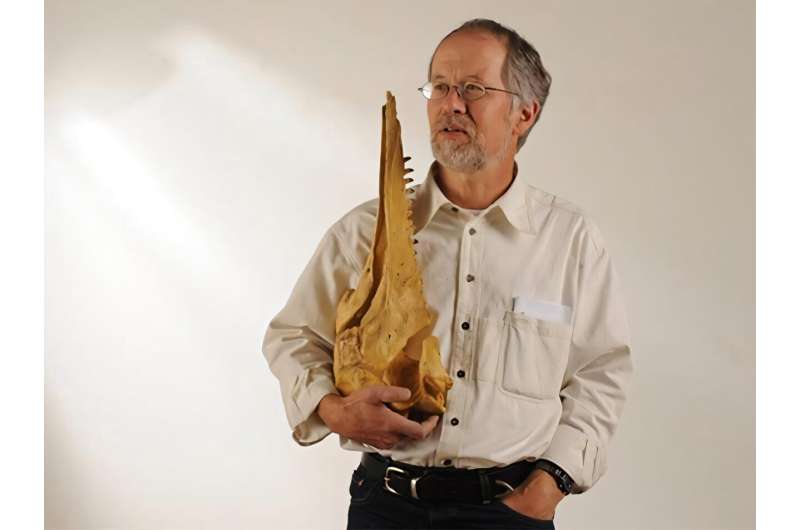Science
New Fossil Billfish Species Celebrates Legacy of Ewan Fordyce

A new species of fossil billfish has been named to honor the influential paleontologist, Emeritus Professor Ewan Fordyce. The species, Zealandorhynchus fordycei, recognizes Fordyce’s significant contributions to vertebrate paleontology during his 40-year tenure at the University of Otago in New Zealand. Fordyce passed away in November 2023, but his impact continues to inspire new generations of researchers.
The announcement comes from a paper published in the journal Gondwana Research, detailing the discovery of two large fossil billfish skulls dating back to the early Eocene, approximately 50 million years ago. These specimens were unearthed in Otago, a region in the southern part of New Zealand known for its rich paleontological history. Billfish, which include marlins and swordfish, are characterized by their long, spear-like jaws used for hunting.
Lead author Dr. Seabourne Rust emphasizes the significance of these findings. “The more complete skull belongs to a new genus and species that we have named Zealandorhynchus fordycei, after the late Professor Fordyce,” he explains. This discovery adds valuable information to the sparse fossil record of early Eocene fish in New Zealand.
The skulls were discovered by co-author Morne Wium, near the location of another fossil fish skull found nearly 40 years earlier. Both specimens are now part of the Earth Science New Zealand National Paleontological Collection. Due to their substantial size, they are believed to have belonged to adult billfish, which likely measured several meters in length.
Dr. Rust notes the implications of these findings for understanding ancient marine life. “These billfish specimens represent notable additions to a rather sparse Early Eocene fish macrofossil record from New Zealand,” he states. “They hint at ancient diversity and widespread southern distribution reached by early billfishes during the Eocene. This is very significant as previously known distribution was considered to be nearly exclusive to the northern hemisphere.”
Dr. Rust’s connection to Fordyce runs deep. After completing his undergraduate studies at Otago, he worked under Fordyce’s mentorship for his Master of Science thesis on fossil fish from the university’s Geology Museum collections between 1997 and 2000. “Ewan gave so much to his students; his well-illustrated lectures and legendary field trips brought the subject to life,” he reflects. “He was a guiding mentor for me and many other budding paleontologists.”
Fordyce’s work on fossil vertebrates from Southern Zealandia has had a lasting impact. Many of his significant discoveries were made during fieldwork in North Otago and Canterbury, focusing on ancient whales and dolphins, a specialty of his. “My colleagues and I felt very privileged to honor Ewan’s memory by naming our new fossil billfish taxon after him,” Dr. Rust adds.
The research contributes to a broader understanding of the aquatic ecosystem during the Eocene epoch and highlights the importance of continued exploration and study of New Zealand’s paleontological resources. For further details, refer to the study published in Gondwana Research. The full citation is: Seabourne Rust et al, Fossil billfish (Xiphioidei) from the Eocene of Hampden, North Otago, New Zealand, Gondwana Research (2026). DOI: 10.1016/j.gr.2025.09.021.
-

 Science3 weeks ago
Science3 weeks agoInterstellar Object 3I/ATLAS Emits Unique Metal Alloy, Says Scientist
-

 Science3 weeks ago
Science3 weeks agoResearchers Achieve Fastest Genome Sequencing in Under Four Hours
-

 Politics4 weeks ago
Politics4 weeks agoAfghan Refugee Detained by ICE After Asylum Hearing in New York
-

 Business3 weeks ago
Business3 weeks agoIconic Sand Dollar Social Club Listed for $3 Million in Folly Beach
-

 Health4 weeks ago
Health4 weeks agoPeptilogics Secures $78 Million to Combat Prosthetic Joint Infections
-

 Lifestyle4 weeks ago
Lifestyle4 weeks agoJump for Good: San Clemente Pier Fundraiser Allows Legal Leaps
-

 Business4 weeks ago
Business4 weeks agoMcEwen Inc. Secures Tartan Lake Gold Mine Through Acquisition
-

 Science4 weeks ago
Science4 weeks agoMars Observed: Detailed Imaging Reveals Dust Avalanche Dynamics
-

 Health3 weeks ago
Health3 weeks agoResearcher Uncovers Zika Virus Pathway to Placenta Using Nanotubes
-

 World4 weeks ago
World4 weeks agoUS Passport Ranks Drop Out of Top 10 for First Time Ever
-

 Entertainment4 weeks ago
Entertainment4 weeks agoJennifer Lopez Addresses A-Rod Split in Candid Interview
-

 Business4 weeks ago
Business4 weeks agoSan Jose High-Rise Faces Foreclosure Over $182.5 Million Loan








